Tenakee Springs, Alaska
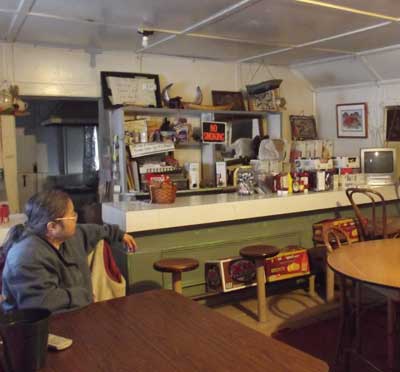 The Blue Moon Cafe is the only restaurant in Tenakee, and proprietor Rosie only cooks when she wants to. Rosie’s actually happy to entertain visitors, it’s just that her old cook stove takes a long time and a lot of effort to start up, so she usually just serves drinks in the off season, along with local legends and gossip. Rosie talked of the times when bears have followed the hunters back home to town, even breaking in to porches. “One of the bears was not too big”, she says holding her hand 4 feet off the ground, “and the other was old and thin with no teeth, but they shot them anyway.” Interested in the old stove, I asked about her appliances, and heard a little about daily life. Just a few of the newer Tenakee homes have clothes washer/dryers, and those people host others’ washing. Rosie wonders why people need the machine and the expense, don’t they know how to wash clothes? You “pack in water” (carry buckets from a stream), wash the clothes in the same tub after you wash yourself, and hang dry. Sunday is ironing day, but we both admitted to skipping ironing most of the time.
The Blue Moon Cafe is the only restaurant in Tenakee, and proprietor Rosie only cooks when she wants to. Rosie’s actually happy to entertain visitors, it’s just that her old cook stove takes a long time and a lot of effort to start up, so she usually just serves drinks in the off season, along with local legends and gossip. Rosie talked of the times when bears have followed the hunters back home to town, even breaking in to porches. “One of the bears was not too big”, she says holding her hand 4 feet off the ground, “and the other was old and thin with no teeth, but they shot them anyway.” Interested in the old stove, I asked about her appliances, and heard a little about daily life. Just a few of the newer Tenakee homes have clothes washer/dryers, and those people host others’ washing. Rosie wonders why people need the machine and the expense, don’t they know how to wash clothes? You “pack in water” (carry buckets from a stream), wash the clothes in the same tub after you wash yourself, and hang dry. Sunday is ironing day, but we both admitted to skipping ironing most of the time.
Monthly Archives: November 2011
A Day in Tenakee Springs, Part 1
Tenakee Springs, Alaska
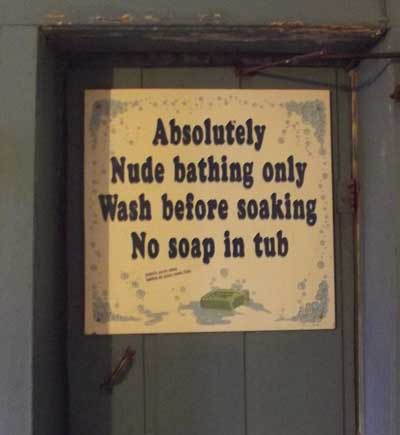 We awaited our next weather window spending about a week in Tenakee Inlet at anchor and at the Tenakee Springs town dock. As this is my first time visiting Alaska, I didn’t mind the chance to see more of the local area. Naturally, Tenakee Springs has a natural hot mineral spring pool, which since the early 1900’s has been enclosed in a bathhouse to protect bathers from harsh weather. This also serves to protect modesty, since to keep the pool pure only nude bathing is allowed, with separate hours scheduled for women and men. Leave the dressing room and step down onto the stone deck in the steamy warm air. The 104F/35C mineral water bubbles out of 8 foot deep fissure and fills the small rock pool. Rinse off before settling in on the stone cut step, and warming up from a day of work on the boat. The mineral water and the heat together are so relaxing and rejuvenating! Thanks very much to the local Tenakee Bathhouse Committee for maintaining the spring and facilities.–
We awaited our next weather window spending about a week in Tenakee Inlet at anchor and at the Tenakee Springs town dock. As this is my first time visiting Alaska, I didn’t mind the chance to see more of the local area. Naturally, Tenakee Springs has a natural hot mineral spring pool, which since the early 1900’s has been enclosed in a bathhouse to protect bathers from harsh weather. This also serves to protect modesty, since to keep the pool pure only nude bathing is allowed, with separate hours scheduled for women and men. Leave the dressing room and step down onto the stone deck in the steamy warm air. The 104F/35C mineral water bubbles out of 8 foot deep fissure and fills the small rock pool. Rinse off before settling in on the stone cut step, and warming up from a day of work on the boat. The mineral water and the heat together are so relaxing and rejuvenating! Thanks very much to the local Tenakee Bathhouse Committee for maintaining the spring and facilities.–
Chatham Strait
Chatham Strait, Alaska
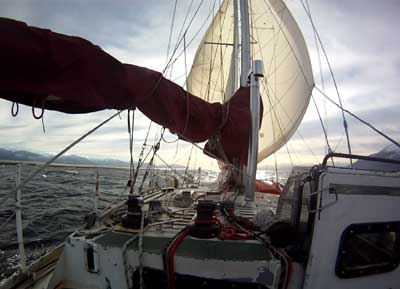 Nice tailwind pushing us down Chatham Strait.–
Nice tailwind pushing us down Chatham Strait.–
Icy Strait
Icy Strait, Southeast Alaska
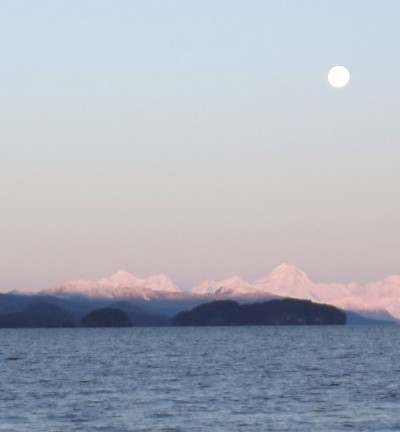 Moon over the mountains, early in the morning in Icy Strait.
Moon over the mountains, early in the morning in Icy Strait.
Eagle
Hoonah, Alaska
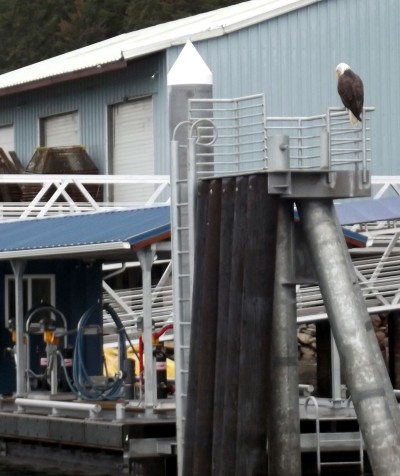 Eagles are plentiful in Southeast Alaska. Here an eagle keeps watch over the fuel dock at Hoonah.
Eagles are plentiful in Southeast Alaska. Here an eagle keeps watch over the fuel dock at Hoonah.
Inian Cove
Inian Cove, Cross Sound, Alaska
 Early in the morning at the entrance to Inian Cove, where we anchored.
Early in the morning at the entrance to Inian Cove, where we anchored.
Away
Cape Spencer, Southeast Alaska
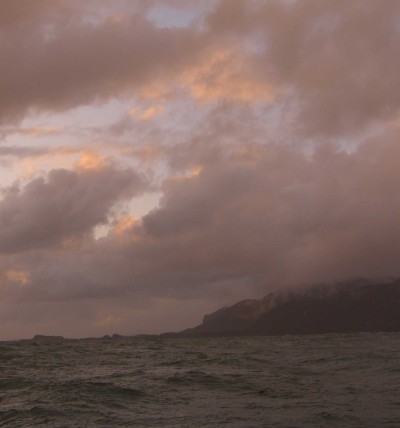 The gales and storms continued as one low pressure system after another reached Alaska. Unexpectedly, one day we suddenly had a forecast of relatively light (25-30 knots) and often favorable winds for several days. For the fourth time, we left Yakutat. We motored (and added sails when the wind was favorable) as quickly as we could, not sure that we really could trust being so lucky as to have several days of light and often favorable winds. The current was at first strong against us, then lessened as we made our way down the coast. Late the next day, we approached Cape Spencer (picture) in good conditions, with a tailwind, intermittent rain and hail from a mild frontal passage, and 5m/16′ following seas.
The gales and storms continued as one low pressure system after another reached Alaska. Unexpectedly, one day we suddenly had a forecast of relatively light (25-30 knots) and often favorable winds for several days. For the fourth time, we left Yakutat. We motored (and added sails when the wind was favorable) as quickly as we could, not sure that we really could trust being so lucky as to have several days of light and often favorable winds. The current was at first strong against us, then lessened as we made our way down the coast. Late the next day, we approached Cape Spencer (picture) in good conditions, with a tailwind, intermittent rain and hail from a mild frontal passage, and 5m/16′ following seas.
Leave, Return, Repeat
Alaska
 Picture is of the sea buoy off Yakutat at dawn. Leaving Yakutat seemed like such an easy trip–about 140 miles southeast to get into Cross Sound (an entrance to the Inside Passage where there are many places to anchor or dock).Our first attempt to leave Yakutat was aborted when a 49knot squall that was not forecast (and caught the fishing fleet by surprise as well) came up as we were about to clear Yakutat Bay.Our second attempt was aborted when we found an unexpectedly strong 1.5knot current running against us. We had only two days before a SE storm was to arrive and the timing of getting into an unfamiliar port in time to secure for a storm was too tight for comfort, so we returned to the safety and comfort of Yakutat again.Low pressure systems kept coming into the Gulf of Alaska, and bringing mostly strong to storm-force SE winds to the coast where we were. There wasn’t much of a gap between the storms, and they seemed to be forming faster and faster as October ended and November began.The pilot chart (which shows average winds and currents for the oceans) showed pretty much no prevailing winds (but that is for a larger area). The Coast Pilot mentioned a current running along the coast that was variable in direction and speed, and mentioned that winds tended to run along the coast (in either direction) instead of crossing it.On our third attempt, we left before dawn with a forecast for east winds, 30 knots, with 50 knots out of bays and passes, and almost two days before the next southeast storm. It didn’t sound great, but it did sound possible.We couldn’t quite sail the southeast course without tacking, so motored close to shore, in relatively shallow water where we expected the least current. This time, the current was running two knots against us. The first bit of the coast was fine, then the wind steadily increased and our speed dropped. Motoring as fast as possible, we spent several hours making 1 to 1.5 knots.I considered setting sails to go faster, but that would have taken us farther from the shelter of the shore, so the waves would have increased and waves from storm-force (50 knot) winds are never good.We hand steered to maintain course. Because we were close to shore, the waves were small–less than a metre, but many were crossing the deck and most were getting the tops blow off by the wind, so it was very wet on deck.The temperature was a few degrees above freezing and forecast to go well below freezing that night.A friend on a fishing boat ahead of us radioed to say that the wind eased ten miles further. Only ten miles! The sun was soon to set, and at 1 to 1.5 knots, we would need to hand steer outside for several hours after dark until we got to where the wind was less. It would be quite tough on us standing outside steering with the constant spray in the below-freezing temperatures at night.The critical thing to keep in mind about travelling in high latitudes is how easy it is to get into a survival situation. The Gulf of Alaska (and anywhere that far north) is a really unforgiving place in November. We weren’t in any danger, but, if we wore ourselves out by getting cold hand-steering outside for hours in freezing spray, the danger was that if anything went wrong (like an engine problem, or taking on water), we would be exhausted, and not necessarily capable of quick, rational thinking and action.We had tried for several weeks to leave Yakutat, and knew this break in the weather might be the last one until spring.It is really hard to turn back, when you know you are likely to make it if you just persevere and tough it out. But while the risk of something going wrong was small, it was still there, and I decided it was better to return to Yakutat.We turned around. Before easing off the throttle and setting sails (as the wind was now with us), we were making 8.7 knots. We had spent all day coming less than 30 miles, and we were soon back at the dock in Yakutat,Was Issuma going to spend the winter in Yakutat? —
Picture is of the sea buoy off Yakutat at dawn. Leaving Yakutat seemed like such an easy trip–about 140 miles southeast to get into Cross Sound (an entrance to the Inside Passage where there are many places to anchor or dock).Our first attempt to leave Yakutat was aborted when a 49knot squall that was not forecast (and caught the fishing fleet by surprise as well) came up as we were about to clear Yakutat Bay.Our second attempt was aborted when we found an unexpectedly strong 1.5knot current running against us. We had only two days before a SE storm was to arrive and the timing of getting into an unfamiliar port in time to secure for a storm was too tight for comfort, so we returned to the safety and comfort of Yakutat again.Low pressure systems kept coming into the Gulf of Alaska, and bringing mostly strong to storm-force SE winds to the coast where we were. There wasn’t much of a gap between the storms, and they seemed to be forming faster and faster as October ended and November began.The pilot chart (which shows average winds and currents for the oceans) showed pretty much no prevailing winds (but that is for a larger area). The Coast Pilot mentioned a current running along the coast that was variable in direction and speed, and mentioned that winds tended to run along the coast (in either direction) instead of crossing it.On our third attempt, we left before dawn with a forecast for east winds, 30 knots, with 50 knots out of bays and passes, and almost two days before the next southeast storm. It didn’t sound great, but it did sound possible.We couldn’t quite sail the southeast course without tacking, so motored close to shore, in relatively shallow water where we expected the least current. This time, the current was running two knots against us. The first bit of the coast was fine, then the wind steadily increased and our speed dropped. Motoring as fast as possible, we spent several hours making 1 to 1.5 knots.I considered setting sails to go faster, but that would have taken us farther from the shelter of the shore, so the waves would have increased and waves from storm-force (50 knot) winds are never good.We hand steered to maintain course. Because we were close to shore, the waves were small–less than a metre, but many were crossing the deck and most were getting the tops blow off by the wind, so it was very wet on deck.The temperature was a few degrees above freezing and forecast to go well below freezing that night.A friend on a fishing boat ahead of us radioed to say that the wind eased ten miles further. Only ten miles! The sun was soon to set, and at 1 to 1.5 knots, we would need to hand steer outside for several hours after dark until we got to where the wind was less. It would be quite tough on us standing outside steering with the constant spray in the below-freezing temperatures at night.The critical thing to keep in mind about travelling in high latitudes is how easy it is to get into a survival situation. The Gulf of Alaska (and anywhere that far north) is a really unforgiving place in November. We weren’t in any danger, but, if we wore ourselves out by getting cold hand-steering outside for hours in freezing spray, the danger was that if anything went wrong (like an engine problem, or taking on water), we would be exhausted, and not necessarily capable of quick, rational thinking and action.We had tried for several weeks to leave Yakutat, and knew this break in the weather might be the last one until spring.It is really hard to turn back, when you know you are likely to make it if you just persevere and tough it out. But while the risk of something going wrong was small, it was still there, and I decided it was better to return to Yakutat.We turned around. Before easing off the throttle and setting sails (as the wind was now with us), we were making 8.7 knots. We had spent all day coming less than 30 miles, and we were soon back at the dock in Yakutat,Was Issuma going to spend the winter in Yakutat? —
Snow
Yakutat, Alaska
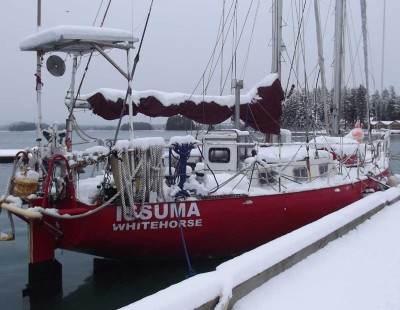 November in Alaska. Hmmm.
November in Alaska. Hmmm.
Website Update
Yakutat, Alaska
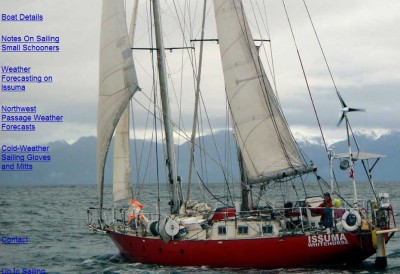 My notes on Weather Forecasts for the Northwest Passage are now on my website at Northwest Passage Weather Forecasts
My notes on Weather Forecasts for the Northwest Passage are now on my website at Northwest Passage Weather Forecasts